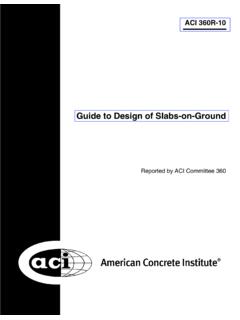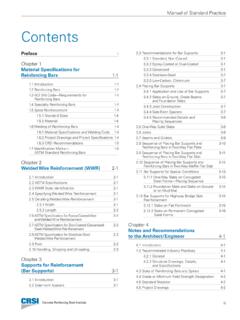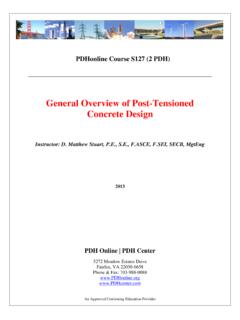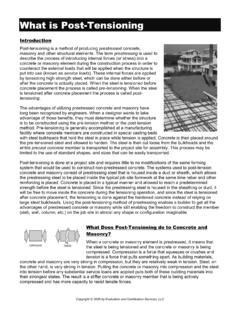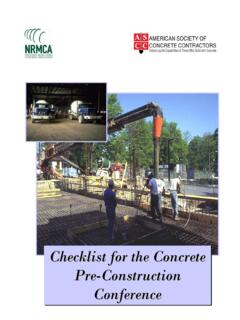Transcription of Guidelines for the Design of Post-Tensioned Floors
1 Guidelines forthe Design ofPost- tensioned FloorsBY BIJAN O. AALAMI AND JENNIFER D. JURGENShis article presents a set of Guidelines intended toassist designers in routine post-tensioning Design ,Tbeginning with a discussion of the initial decisions thatmust be made to Design Post-Tensioned floor members. Wethen provide a set of recommendations, derived fromindustry practice, which have yielded economical designswith good in-service performance. Where applicable, webased the Guidelines on ACI 318-021 and IBC the purpose of this article, we have assumed thatthe Design engineer is familiar with the concept andapplication of post-tensioning. There are a number ofgood references on the topic of Wehave further assumed that the Design engineer knowsboth the geometry of the structure and the loading; thisarticle discusses the Design process that follows thedetermination of the structure s geometry and Guidelines presented in this article result frommore than 20 years of extensive and varied designexperience in post-tensioning, including considerablereview of designs by other engineers.
2 Based on theobserved performance of structures built in accordancewith these Guidelines , we know the Guidelines lead tosafe structures with good in-service performance. Wehope that the Guidelines will assist Design engineers inthe selection of the various Design parameters. Choosingappropriate values for the various Design parameters isparticularly important for engineers using the FiniteElement Method (FEM) in their designs because thecurrent FEM technology requires that the engineer layout the tendons, including the shape and force of eachtendon, before a solution can be Guidelines apply to typical buildings and parkingstructures. Special loading conditions or unique geometriesmay require values other than those specified in thisarticle.
3 In addition, local practice, availability of material, orthe contractor s equipment and skill may sometimes makeother alternatives more economical or required for the preliminary Design of afloor system that are not discussed in this article, butare covered in other literature, include establishingslab and beam dimensions and concrete cover. ThePost-Tensioning Institute (PTI) Design Manual6 givesrecommended span-to-thickness ratios for slabs andspan-to-depth ratios for is determined from the requirements forcorrosion protection, fire protection, and wear. ACI 3627and ACI give recommendations and requirementsfor post-tensioning systems intended for use in aggressive(corrosive) environments. The IBC, ACI 318-02, andACI provide information on cover requirements forcorrosion and fire protection.
4 Additional cover for wearis discretionary; it is sometimes specified for structuressuch as parking garages where abrasion may result inexcessive SYSTEMSIn the and Canada, Post-Tensioned buildings andparking garages are typically constructed with seven-wire, ( mm), unbonded single-strand(monostrand) tendons. These tendons, with a typicalstrength of 270 ksi (1860 MPa), are also greased andsheathed. One reason for the widespread use of strand is the Code requirement that thetendon spacing not be greater than eight times the slabthickness. The use of , 270 ksi (1860 MPa)strand permits and thick (110 and 125 mm)slabs to meet both the minimum 125 psi ( MPa)average precompression and the maximum tendonConcrete international / MARCH 2003 77spacing requirement.
5 In addition, the tendons and stressingequipment are light enough for workers to handle themefficiently on site. Larger diameter ( in. [ mm])strands are primarily used in pretensioning and bridgeconstruction. Higher strength steels and smaller diameterstrands are also available but are not commonly used fornew MODELINGIn both one- and two-way systems, specifying thestructural model includes defining the Design strips,irrespective of whether an FEM or Equivalent FrameMethod of analysis is The distinction betweenone- and two-way systems is important because thedesign requirements in ACI 318-02 are different for thetwo systems. Column-supported Floors generally qualifyas two-way systems; beam- and wall-supported slabs andbeams generally qualify as one-way systems.
6 For adetailed discussion of one- versus two-way systems,refer to fixity of the connections must also be some instances, such as corner columns in flatslabs, and strong beam/weak column connectionsat the upper levels of one-way slab and beamconstruction, the assumption of full fixity does notyield a satisfactory Design . For structural analysis,such connections may be assigned partial fixity ormay be assumed as hinged connections (releases).Connections that are assumed to be hinged must bedetailed in the construction documents to allowrotation, while retaining the integrity of the jointby limiting crack width and transfer of axial andshear forces through the joint. Another instancewhere a hinge connection may be beneficial isfor short gravity columns at split levels in parkingstructures, which have a ramp on one side and alevel floor on the other DECISIONST here is a major difference between the Design of apost- tensioned member and the Design of a conventionallyreinforced concrete member.
7 Once the geometry, loading,support conditions, and material properties of aconventionally reinforced member (Fig. 1(a)) areestablished, a unique solution of the required area ofreinforcement, As, is given by a formula. For a Post-Tensioned member (Fig. 1(b)), however, there are anumber of acceptable reinforcement designs becausethere are several additional parameters that must bespecified by the engineer. These parameters may begrouped as follows:PAverage precompression (prestressing force);PPercentage of load to balance (uplift due to tendondrape); andPTendon profile (shape and drape).From the many possible Design solutions for apost- tensioned member, the one that meets the Coderequirements for serviceability and strength and is theleast expensive to build is usually the preferred , for a given slab dimension, loading, andconstruction method, less material means a moreeconomical Design .
8 There is a unique value for thedesign moment, Mu, for the conventionally reinforcedbeam shown in Fig. 1(a), which leads to a unique valuefor the required area of steel, As. For the post-tensionedalternative shown in Fig. 1(b), the Design momentincludes secondary (hyperstatic) effects and is thus afunction of the post-tensioning. Values for the threeparameters listed previously must be established beforethe required amount of post-tensioning can be amount of supplemental reinforcement, As, requiredfor strength Design of the post-tensioning member isdetermined by the amount of the post-tensioningreinforcement and the reinforcement precompressionThe average precompression is the total post-tensioning force divided by the gross cross-sectionalarea normal to the force.
9 ACI 318-02 requires a minimumof 125 psi ( MPa) effective precompression(precompression after all prestress losses).In general, 125 psi ( MPa) should be used forthe initial average precompression. For roofs and parkingstructures, use 150 to 200 psi ( to MPa) if water-tightness or cracking is a concern. Bear in mind, however,that an increase in precompression does not guaranteewatertightness and may not completely eliminate avoid leakage, the increased post-tensioning must besupplemented by other measures, such as a membraneoverlay. In stemmed structures, such as one-way slaband beam construction, the entire cross-sectional areaof the member should be used when computing theaverage 2(a) shows the tributary for axial is further explained in the section on anchorlocations.
10 (In one-way slab and beam construction, themember is defined as the beam and its tributary slabarea.) Maximum precompression should be 275 psi( MPa) for slabs and 350 psi ( MPa) for beams;although the Code s limit of maximum compressivestress is much higher, values higher than these typicallymean the Design will be less of load to balancePost-tensioning is typically thought of as a system ofloads that counteracts the dead load of the is expressed as the ratio (percentage) of the deadload that is balanced. For slabs, it is customary tobalance between 60 and 80% of the dead load. Forbeams, this is usually increased to between 80 and 110%.78 MARCH 2003 / Concrete internationalOne reason for higher balanced loading for the beamsis that beam deflection is more critical to serviceperformance of a floor system.

